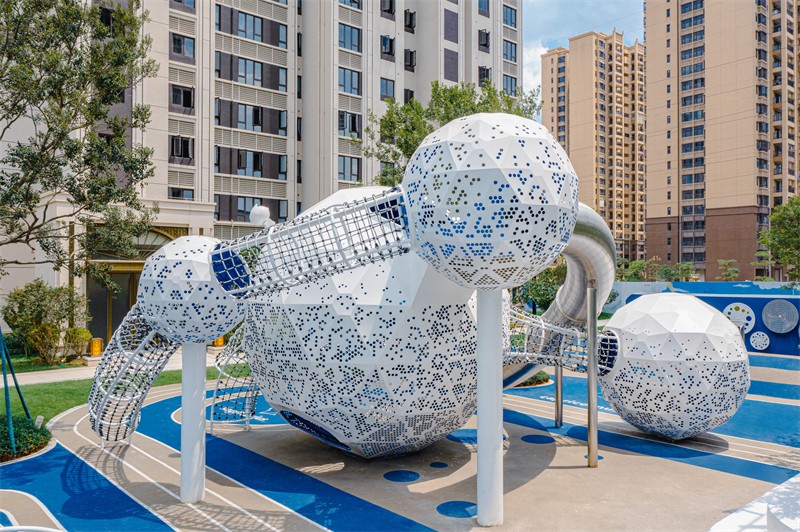As society's focus on children's healthy development grows, non-powered children's play facilities are becoming increasingly popular in various venues due to their safety, environmental friendliness, and creativity-stimulating features. These facilities require no electricity and rely on natural gravity or children's own strength to play, satisfying children's need for exploration while reducing operating costs. This article will delve into five key use cases for non-powered facilities, providing practical reference for urban planners, scenic area operators, and commercial entities.
1. Community Parks: "Natural Playgrounds" at Your Doorstep
Community parks are important venues for children's daily activities. Strategically placed non-powered play facilities can transform ordinary green spaces into spaces for parent-child social interaction.
Functional Compatibility:
Combined with basic equipment such as slides, climbing nets, and swings, these facilities cater to the diverse needs of children aged 3-12. For example, sandpits and rocking horses are suitable for younger children, while climbing walls and balance beams can be challenging for school-age children.
Social Value:
Parents accompanying their children fosters neighborhood interaction and fosters community cohesion. After a Shanghai community introduced a rainbow tunnel and megaphone system, children's average daily play time increased by 40%, significantly boosting parent satisfaction.
Design Key Points:
Anti-collision soft rubber flooring and rounded corners ensure safety; terrain elevation differences create interesting movement routes and reduce space usage.

2. Kindergartens and Schools: A "Secret Weapon" for Physical Training
Educational institutions can integrate play with physical development through non-powered play facilities.
Teaching Integration:
Balance beams improve coordination, climbing frames enhance upper limb strength, and combination equipment promotes teamwork. A kindergarten in Chengdu integrated facilities with the curriculum, increasing the pass rate for children's physical fitness tests by 25%.
Scene Innovation:
Customized themed facilities such as "Adventure Island" and "Space Exploration," such as simulated volcano climbing and a star grid, stimulate imagination.
Safety Management:
Regularly check the security of connectors and establish teacher observation areas to avoid blind spots.
3. Commercial Complexes: A "Golden Draw" for Family Traffic
Shopping malls can significantly extend family stays and drive repeat purchases by creating non-powered children's playgrounds.
Traffic Attraction Strategies:
Themed parks, such as forest adventures and ball pools, can be installed on the top floor or in the atrium to attract target customers. After introducing a popular slide, a shopping mall in Hangzhou saw a 30% increase in weekend traffic and an 18% increase in sales on the food and beverage floor.
Business Model:
Adopting a "free trial + membership value-added services" model, such as paid expansion areas and parent-child classes, increases profitability.
Space Optimization:
Adopting a modular design adaptable to different venues; incorporating parent rest areas and monitoring systems enhances the service experience.
4. Tourist Attractions: A "Check-in Spot" for Family Trips
Natural scenic spots can transcend the limitations of "sightseeing tours" by developing non-powered facilities and create in-depth experiential experiences.
Ecological Integration:
Utilizing resources such as forests and slopes, tree house adventures and jungle trekking programs can be developed to reduce environmental damage. A scenic spot in Huangshan, taking advantage of the mountain's terrain, designed a non-powered roller coaster, which has become an internet sensation.
Theme Creation:
Integrating local culture, such as a Mongolian yurt-shaped maze in a grassland scenic area and a fishing boat climbing frame in a seaside scenic area, enhances memorable moments.
Seasonal Adaptation:
Incorporating sunshades and anti-freeze materials allows for year-round operation; developing interactive nighttime lighting installations extends operating hours.
V. Rural Cultural Tourism: A "Distinctive Business Card" for Rural Revitalization
Rural tourism projects can revitalize idle resources and attract urban families through the construction of non-powered amusement parks.
Local Elements:
Using materials such as wood and millstones, scarecrow mazes and waterwheel play areas highlight rural characteristics. A village in Zhejiang province transformed an abandoned granary into a three-dimensional climbing tower, attracting over 100,000 visitors annually.
Integrating Agriculture and Tourism:
Developing interactive games such as "Picking + Challenge" and "Farmland Maze" extends the value chain.
Cost Control:
Prioritizing the procurement of standardized components and training villagers in maintenance to reduce operating costs.
Conclusion: Activating the Value of Space with Non-Powered Facilities
From communities to scenic spots, non-powered children's play facilities are reshaping the children's activity ecosystem with diverse applications. Their core value lies in "natural companionship" and "growth empowerment"—inspiring children's courage through low-risk challenges and fostering social skills through interaction. For operators, precise equipment selection based on the characteristics of the venue and target audience, while also focusing on ongoing maintenance and thematic event planning, can achieve a win-win situation for both social and economic benefits.
Future Trends: With the integration of intelligent technology, innovative forms such as interactive audio-visual installations and AR physical games will further expand the boundaries of non-powered facilities, creating richer growth experiences for children.
+86-13566236059
#16 Chuangqiang Road, Light industrial area, Lucheng district, Wenzhou city, Zhejiang Province, China.
+86-577-85951908
+86-577-86457291
